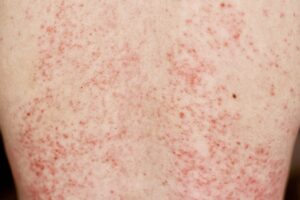August 13, 2025 | Black & Kletz Allergy
 Toxic epidermal necrolysis (TEN) is a painful, life-threatening skin condition. It is associated with blistering and peeling of large areas of the skin, including mucous membranes such as the mouth, eyes, and/or genitals. If less than 10% of the body surface is involved, it is often called Stevens- Johnson syndrome (SJS).
Toxic epidermal necrolysis (TEN) is a painful, life-threatening skin condition. It is associated with blistering and peeling of large areas of the skin, including mucous membranes such as the mouth, eyes, and/or genitals. If less than 10% of the body surface is involved, it is often called Stevens- Johnson syndrome (SJS).
In the more severe form, which is referred to as toxic epidermal necrolysis, usually more than 30% of the body surface area is affected. These 2 conditions overlap when between 10 and 30% of body surface is involved.
The most common cause of toxic epidermal necrolysis is an adverse reaction to medications. The most common medications implicated in the causation are antibiotics and anti-seizure medications.
Fortunately, toxic epidermal necrolysis/Stevens-Johnson syndrome is a very rare complication of medication use where it is estimated that there are 0.4 – 1.2 cases per million each year for toxic epidermal necrolysis and 1 – 2 cases per million each year for Stevens-Johnson syndrome. Certain genetic factors may predispose one to this condition. It can affect all age groups and is slightly more common in females than in males. Toxic epidermal necrolysis is 100 times more common in association with human immunodeficiency virus infection (HIV).
The most common medications causing toxic epidermal necrolysis are:
- Sulfonamides: Bactrim (i.e., sulfamethoxazole + trimethoprim)
- Beta-lactam Antibiotics: penicillins, cephalosporins
- Anticonvulsants: Lamictal (i.e., lamotrigine), Tegretol (i.e., carbamazepine, Dilantin (i.e., phenytoin), phenobarbital
- Allopurinol – A medication to lower high uric acid levels)
- Tylenol (i.e., acetaminophen or paracetamol)
- Viramune (i.e., nevirapine) – An anti-HIV medication
- Nonsteroidal Anti-Inflammatory Drugs (NSAIDs)
- Anti-cancer Medications
Toxic epidermal necrolysis/Stevens-Johnson syndrome has rarely been associated with vaccination or mycoplasma and cytomegalovirus infections. Infections are generally associated with mucosal involvement and less severe cutaneous disease than when drugs are the cause.
Symptoms:
Toxic epidermal necrolysis usually develops within the first week of antibiotic therapy but typically develops up to 2 months after beginning an anticonvulsant. Before the rash appears, there is usually a prodromal illness of several days duration resembling an upper respiratory tract infection or flu-like illness. The symptoms for this prodromal illness may include a mild fever, sore throat, achiness, watery eyes, red eyes, nasal congestion, runny nose, cough, and/or generalized fatigue.
This prodromal stage is followed by a tender or painful red skin rash, beginning on the trunk and extending rapidly over hours to days onto the face and limbs, but rarely affecting the scalp, palms, or soles). Initially, reddish areas and small blisters may develop. The blisters then merge to form sheets of skin detachment causing redness and oozing from deeper layers of the skin. Erosions, or painful open wounds that look like burns, develop as the skin peels away.
Mucosal involvement is prominent and severe, although no actual blisters are formed. At least 2 mucosal surfaces are affected including:
- Eyes – red, soreness, stickiness, photosensitivity
- Lips/Mouth – red crusty lips, painful mouth ulcers
- Pharynx/Esophagus – difficulty eating
- Genital Area and Urinary Tract – erosions, ulcers
- Upper Respiratory Tract – cough, respiratory distress
- Gastrointestinal Tract – diarrhea
Complications:
Toxic epidermal necrolysis/Stevens-Johnson syndrome can be fatal due to complications in the acute phase. The mortality rate is up to 10% for Stevens-Johnson syndrome and at least 30% for toxic epidermal necrolysis.
During the acute phase, potentially fatal complications may include:
- Dehydration and/or acute malnutrition
- Infection of the skin, mucous membranes, lungs (i.e., pneumonia), septicemia (i.e., blood poisoning) with bacteria or fungus
- Acute respiratory distress syndrome
- Gastrointestinal ulceration and/or perforation
- Shock and multiple organ failure
- Excessive blood clotting and/or bleeding
Diagnosis:
A skin biopsy is usually required to confirm the clinical diagnosis. Blood tests do not help make the diagnosis but are essential to monitor if fluid and vital nutrients have been replaced, as well as to identify complications. Bloodwork can identify anemia, low WBC’s and platelets, elevated liver enzymes and/or protein loss in the urine which are not uncommon in this condition.
Treatment:
- Immediate discontinuation of the suspected triggering drug
- Nutritional and fluid replacement
- Temperature maintenance
- Pain relief
- Sterile handling and reverse isolation
- Systemic antibiotics at the first sign of an infection
- Topical antiseptics such as silver nitrate and chlorhexidine
- Dressings such as gauze with petrolatum (i.e., petroleum jelly)
- Frequent eye drops/ointments (e.g., antiseptics, antibiotic, corticosteroids)
- Mouthwashes and oral anesthetics
- Corticosteroids and immunosuppressant medications
- Immune globulin supplementation
The board certified allergy specialists at Black & Kletz Allergy have 3 locations in the Washington, Northern Virginia, and Maryland metropolitan area. Our offices are located in Washington, DC, McLean, VA (Tysons Corner, VA), and Manassas, VA. All of our offices have on-site parking and the Washington, DC and McLean, VA offices are also Metro accessible. The McLean office has a complementary shuttle that runs between our office and the Spring Hill metro station on the silver line. The allergists at Black & Kletz Allergy diagnose and treat both pediatric and adult patients. To make an appointment, please call our office or you may click Request an Appointment and we will respond within 24 hours by the next business day. The allergy doctors at Black & Kletz Allergy have been helping patients with allergic skin disorders, as well as and other allergic conditions such as hives, eczema, hay fever, asthma, sinus disease, food allergies, medication allergies, insect sting allergies, and immunological disorders for more than 50 years. If you suffer from an allergic skin condition or any other type of allergy, it is our mission to improve your quality of life by decreasing or preventing your unwanted and annoying allergy symptoms.












